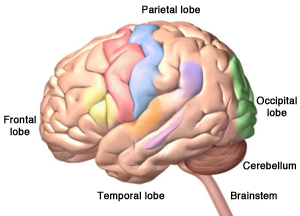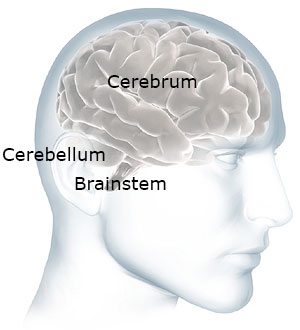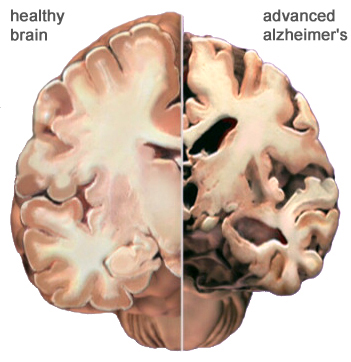In this course we will discuss dementia. We will explain how dementia affects the brain. We will discuss how Alzheimer’s disease differs from other types of dementia. We will go over behaviors you will see in people with mild, moderate, and severe dementia. Finally, we will discuss communication issues you might see at different stages of dementia.
The Human Brain

The four lobes of the cerebrum, plus the cerebellum and the brainstem. Alzheimer’s disease starts in the temporal lobe. Copyright, Zygote Media Group, Inc. Used with permission.

The cerebellum and brainstem are at the back of your head below the cerebrum.
Alzheimer’s disease and other types of dementia are caused by damage to the brain. The part of the brain that is damaged in dementia is called the cerebrum. The cerebrum fills up most of our skull and is divided into four lobes:
- Frontal lobes
- Temporal lobes
- Parietal lobes
- Occipital lobes
The cerebrum is what makes us human—it does our thinking, remembering, talking, and understanding. It controls our emotions. It helps us reason and make decisions and helps us tell right from wrong. It also controls our movements, vision, and hearing. Many of these areas of the cerebrum are damaged by dementia.
Our brain has two other important parts: the cerebellum and the brainstem. Touch the back of your head just above your neck. The cerebellum is right there. It controls coordination and balance.
Now move your hand a little down and stop before your get to your spine. The brainstem is right there—at the back of the head, above your spine. It connects the brain to the spinal cord. The brainstem oversees automatic things like breathing, digestion, heart rate, and blood pressure. The cerebellum and the brainstem are not affected by dementia.
What Is Dementia?
Dementia is a brain disease. It is progressive, meaning it gets worse over time. Alzheimer’s disease (AD) is the most common kind of dementia.
AD begins in the area of the brain that makes new memories. That’s why someone with AD forgets something that happened just a moment ago.
Other types of dementia begin in areas of the brain involved with thinking and reasoning. Although dementia can start in one part of the brain, eventually it will affect the entire brain.
Emotions are also affected when someone gets dementia. That’s why someone with Alzheimer’s disease and other types of dementia has difficulty controlling their emotions.
When someone has dementia their thinking becomes less clear. Decisions are more difficult and safety awareness declines. People also get tired more easily. Eventually, people with dementia lose the ability to take care of themselves.
For people between the ages of 65 and 75, only about 5% will get any sort of dementia. For people over the age of 85, about 40% will experience some form of dementia. Even so, dementia is not considered a normal part of aging.
How Does Dementia Affect the Brain?
Dementia changes the entire brain. In Alzheimer’s disease, nerve cells in the brain die and are replaced by something called plaques and tangles. As the nerve cells die, the brain gets smaller. Over time, the brain shrinks, affecting nearly all its functions.
Normal Brain Contrasted with AD Brain

A view of how Alzheimer’s disease changes the whole brain. Left side: normal brain; right side, a brain damaged by advanced AD. Source: Courtesy of The Alzheimer’s Association. Used with permission.
